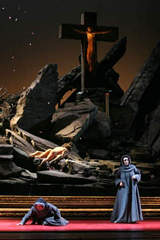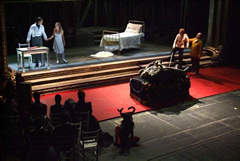| Opera Reviews | 24 April 2024 |
| A
double bill with mixed results by Silvia Luraghi |
|
| Hindemith: Sancta Susanna Corghi: Il dissoluto assoluto Teatro alla Scala 28 September 2006 |
|
|
Problems between the conductor and the orchestra notoriously led to Muti's resignation; the Maestro then conducted Sancta Susanna at the Ravenna Festival during the summer of 2005, while the world premiere of Il dissoluto assolto took place in Lisbon at about the same time. The new administration of La Scala decided to stage the double bill in this season, even if the stage director Giancarlo Cobelli refused to direct the production without Muti. He was replaced in Milan by Patrizia Frini, who used the sets originally designed for Cobelli and essentially reproduced his concept. Paul Hindemith composed Sancta Susanna as part of a trilogy, which also included Mörder, Hoffnung der Frauen and Das Nusch-Nuschi. These two works premiered in 1921, but Sancta Susanna was not performed because of its obscene content. A few years later, Hindemith decided to withdraw it because he now thought that it was too shocking. The action takes place in a nunnery, where a nun, Sister Klementia, tells the younger and highly mystical Susanna a story she witnessed years before, when Sister Beata came naked into the church and embraced the crucifix; she was then walled up alive in punishment. Excited, Susanna identifies herself with Beata, undresses looking at the crucifix, and, when the mother superior steps in, raving asks to be walled up alive. Hindemith's expressionistic music is partly atonal and highly dramatic, and calls for perfectly tuned voices, as were those of Tatiana Serjan (Susanna) and Brigitte Pinter (Klementia). The sets by Alessandro Ciammarughi consisted in an enormous golden frame on the background; inside the frame Susanna's wildest fantasy materialized (a couple having sex, perhaps Adam and Eve), or magnified the interior setting of the church (a giant spider crossing the altar, the crucifix shining with lights in the darkness). Conductor Marco Letonja conducted with the necessary tension and kept the audience breathless for the duration of the opera. |
|
|
But when Donna Anna and Don Ottavio also join the company, we learn from Anna that Don Giovanni did not rape her, simply because he is impotent. Giovanni tries to deny her word by showing his catalogue, but Elvira has stolen it. Giovanni then kills Ottavio in a duel; when the women leave, taking away the corpse, he remains alone humiliated, but Zerlina suddenly comes in and embraces him: he deserves to be absolved. Corghi's score alternates echoes from Mozart's opera to newly composed, mostly tonal music; the cast included Vito Priante (Don Giovanni), Julian Rodescu (Commendatore), Roberto de Candia (Leporello), Sonia Bergamasco (Donna Elvira), Sonia Barbadoro (Donna Anna), Laura Catrani (Zerlina), Mirko Guadagnini (Don Ottavio), Luca Casalin (Masetto), and countertenor Marco Lazzara as Donna Elvira's mannequin. They alternated singing with reciting (especially the women) and bravely delivered all demands of the score with commitment, as did the conductor Marco Letonja. However the performance remained quite dull and the audience, not especially numerous, also remained quite perplexed. |
|
| Text ©
Silvia Luraghi Photos: © Marco Brescia / Teatro alla Scala |

 Originally
planned for April 2005 at La Scala, the double bill Sancta Susanna
/ Il dissoluto assolto was cancelled when Riccardo Muti refused
to attend the rehearsals after orchestra members declared that they
would go on strike on opening night of all upcoming productions.
Originally
planned for April 2005 at La Scala, the double bill Sancta Susanna
/ Il dissoluto assolto was cancelled when Riccardo Muti refused
to attend the rehearsals after orchestra members declared that they
would go on strike on opening night of all upcoming productions.  Azio
Corghi's Il dissoluto assolto, from a novel by Portuguese writer
José Saramago, re-writes the story of Don Giovanni, providing it with
a happy ending. With the background of the golden frame seen in Sancta
Susanna (but the frame is now broken), some of the main events known
from Mozart's opera are summarized during the 65 minutes one-act work,
and partly told with Da Ponte's words: Leporello reads the list of the
Don's conquests to Donna Elvira, the bronze (rather than marble) statue
of the Commendatore comes for dinner to the Don's palace, Masetto rushes
in, looking for Zerlina.
Azio
Corghi's Il dissoluto assolto, from a novel by Portuguese writer
José Saramago, re-writes the story of Don Giovanni, providing it with
a happy ending. With the background of the golden frame seen in Sancta
Susanna (but the frame is now broken), some of the main events known
from Mozart's opera are summarized during the 65 minutes one-act work,
and partly told with Da Ponte's words: Leporello reads the list of the
Don's conquests to Donna Elvira, the bronze (rather than marble) statue
of the Commendatore comes for dinner to the Don's palace, Masetto rushes
in, looking for Zerlina. 





